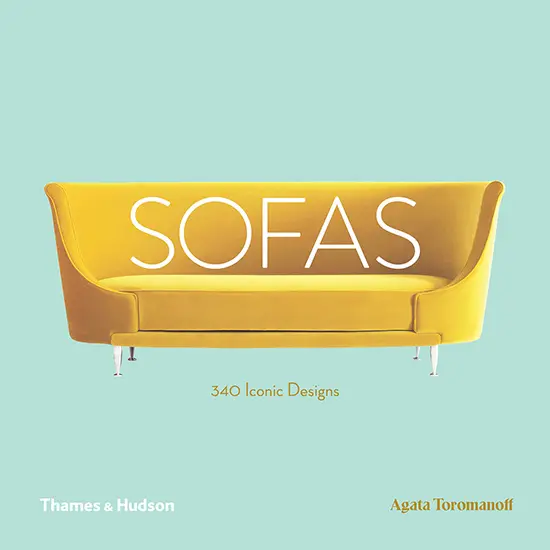In partnership with MiCodmc, a selection of establishments ripe for discovery during the 63rd edition of the Salone del Mobile.Milano, from 8th to 13th April
Two main books to find the right sofa for the right place

The illustrated encyclopedias Sofas. 340 Iconic Designs and Textilepedia guided the fans of design from the first point of choosing the sofa to the final one
Charles-Édouard Jeanneret, best known by his pen name Le Corbusier, passed the severe and provocative judgment on sofas, “Chairs are architecture, sofas are bourgeois". It didn’t stop him and his cousin Pierre Jeanneret together with the designer and the architect Charlotte Perriand from creating one of the most successful sofas. Cassina, the exclusive manufacturer of the trio’s furniture, still produces sofa LC2, which was introduced in 1928 for the villa of the American writer Henry Church, in Ville-d'Avray, France. Its first night took place in 1929 at the Salon d'Automne de Paris during the event "Interior equipment for a home" for the new man. New people demanded new furniture and Le Corbusier with co-authors created it suggesting new, more rational, principles of production – the skeleton from metal tubes was radically separated from the soft cushions, and new, more rational principles of decoration – provocatively simple form of the sofa appeared to be a decoration itself.
Swiss-born in 1877, Le Corbusier took his education at the École des Arts Décoratifs at La Chaux-de-Fonds. Charles L’Eplattenier, whom he called his only teacher, introduced him the world of architecture. His love of Greek architecture deepened during trips there between 1907-1911. Ancient Greek architecture, purism of the protestant houses and interiors accompanying him in his childhood, his enthusiasm to art, specially sculpture, lead to the appearance of the clean and clear lines of his architectural and furniture objects based on the classical proportions. That’s why he is widely regarded as the Father of Functionalism, Internationalism, as well as the Godfather of all modern furniture designers. And, yes, if one perceives the aspiration to the comfort as a sign of bourgeoisness, the sofas, included Le Courbusier’s ones, are quiet bourgeois. Le Corbusier was certainly not the only one inspired by the ancient unknown craftsmen. Though appearing in the 16th and 17th century, modern furnishings' roots go deeper, to ancient Egypt, Greece and the Roman Empire. The decline of the later saw the seeming demise of the sofa. It wasn't until French craftsmen returned the sofa, named the chair-back settee, back to the interiors of clients. Wealthy clients. Time flies and they are not a prerogative of prosperous people anymore. By the way, the word sofa comes from Persian suffah, which means “bench”, similar to the Aramaic word sippa - “mat”. English cleric, Samuel Purchas, first to use the now commonly known word sofa in his 1625 book "Purchas this Pilgrimage", devoted to his Arabian travels.

Over time sofas have moved apart its functional boundaries transforming into a place to sleep, a playground, and especially after lockdown, a home office. They accompany us during home parties and TV watching.
According to the information of statista.com, the amount spent on sofas is expected to exceed 35,312 million dollars in 2022. The market is growing annually by 3.56%. Sofas dominate in the interiors turning into the significant decorative element and becoming a loud design statement. Loud and informative. Speaking to your personality and lifestyle, more than any other piece of furniture. Tell me what sofa you have, and I will tell you who you are. They make us be more demanding to its style, design and look for the competent sources of information scrupulously.
Agata Toromanoff is an art and design historian. Since she received her Master’s Degree in Art History at Adam Mickiewicz University in Poznan, she has been working in the art field taking the positions of art project manager, gallery program administrator, art consultant, collaborating with artists as well as designers to create limited edition design objects. In 2016 her book Chairs by Architects appeared. The carefully illustrated volume Sofas. 340 Iconic Designs by Agata Toromanoff was published in 2018 by Thames & Hudson.
This beautiful and indepth 256 page volume, along with 220 illustrations contains prominent sofas created in the 20th and the 21st centuries. They present the icons by 150 designers including design dinosaurs Le Corbusier, Josef Hoffmann, Charlotte Perriand, Alvar Aalto, Arne Jacobsen and contemporary designers and architects Ronan & Erwan Bouroullec, Aric Levy, Daniel Libeskind, Paola Navone, Nendo, David Adjaye. 340 Iconic Designs by Agata Toromanoff is a directory organized in the alphabetical order containing the vivid recommendations for buying sofas and decorating rooms, which will be appreciated by design lovers.
Sofas became the first piece of furniture combining the firm skeleton structure, padding and the upholstery. The Egyptians were the upholstery pioneers burying their pharaohs with the expensive belonging including upholstery furniture. Although the origin of the term “upholstery” comes from the English word “upholder” used to a craftsman making fabric furnishings, the majority of the early upholstery was produced from leather as one of the most pressure resistant material. Life term of sofas mainly depends on the quality of their upholstery. In 2020 Fashionary International Limited published the textile encyclopaedia Textilepedia. This full fabrics guide with easy navigation contains 240 pages with illustrations on which one can find the fullest information about the upholstery including how to choose it, structural peculiarities of yarns and detailed characteristics of fabrics.

Check out the previews


 Stories
Stories










